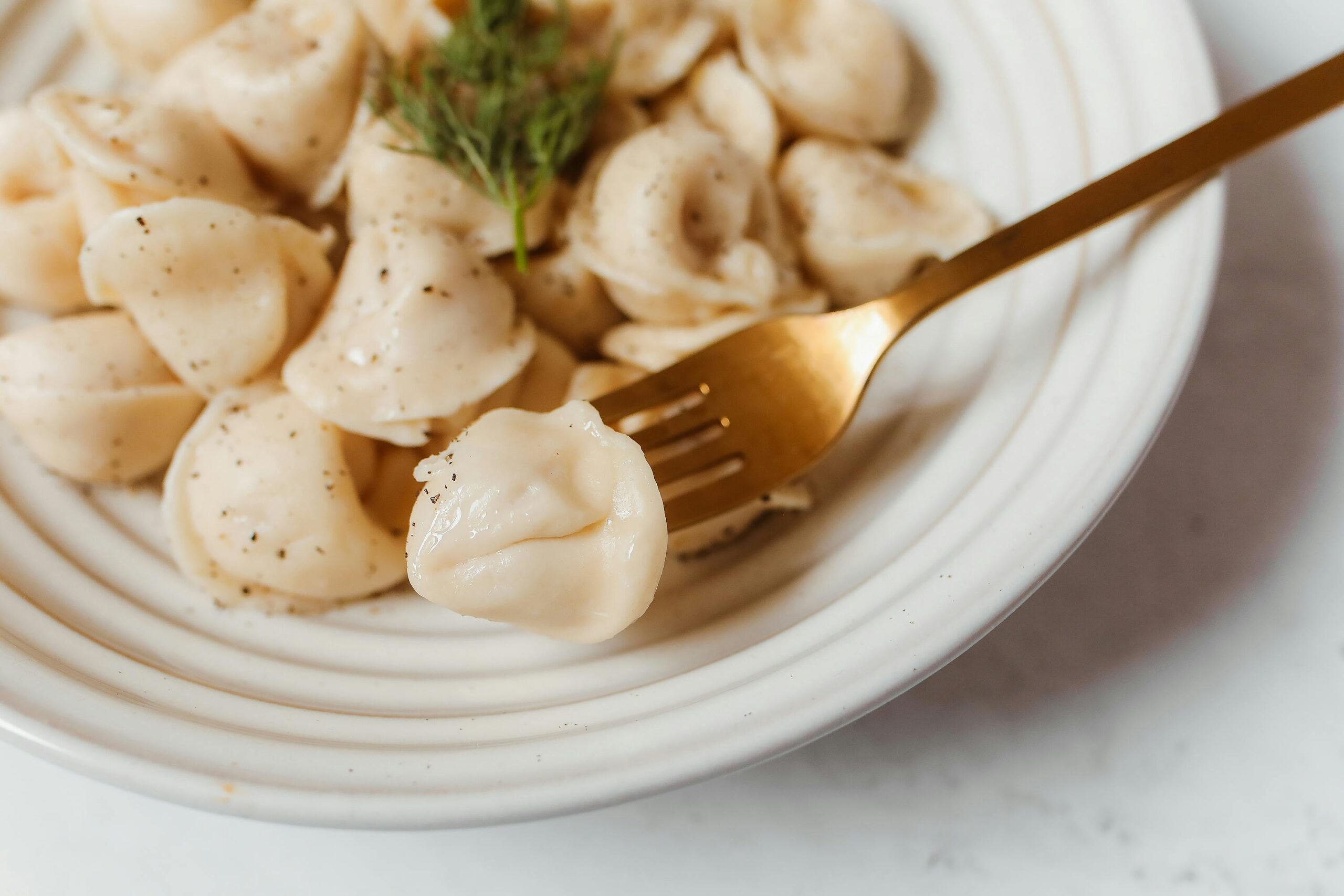Tortellini is a type of pasta that plays an integral role in Italian cuisine, characterized by its unique ring-shaped form that typically encases a filling. These delightful morsels can be found in various fillings, from traditional options like cheese and meats to inventive vegetarian selections. The precise shape and method of preparation vary by region, reflecting Italy’s diverse culinary landscape. Tortellini is often served in broth, in a creamy sauce, or simply drizzled with olive oil, showcasing its versatility and extensive appeal across food enthusiasts worldwide.
In Italian culture, tortellini is not merely a dish but a symbol of family tradition and local pride. Many Italian families have passed down recipes through generations, ensuring that the art of making tortellini remains a cherished cultural experience. This tradition becomes especially evident on special occasions, where the entire family often gathers to prepare the pasta, reinforcing bonds and creating a sense of community. The idiomatic term “tortellinatrice” is attributed to the skilled artisans who dedicate themselves to the craft of tortellini making. The “tortellinatrice” embodies the passion and meticulous techniques necessary for producing authentic tortellini, elevating the dish beyond mere sustenance to an art form.
The origins of tortellini trace back to the Emilia-Romagna region, with Bologna, Modena, and Parma holding significant ties to its history. Folklore suggests that the creation of tortellini was inspired by the goddess Venus, who, in an ancient tale, prompted a cook to replicate the shape of her navel. While the mythological anecdotes are fascinating, they underscore the deep-rooted cultural connection Italians have with their culinary heritage. Through centuries, tortellini has morphed into a symbol of Italian identity, inviting both locals and travelers to partake in its rich history and culture.
The Origins of Tortellini
Tortellini, the beloved pasta shaped like small rings, traces its roots back to Italy’s Emilia-Romagna and Marche regions. This culinary icon has a rich history that dates back several centuries, woven into the cultural tapestry of Italian cuisine. The earliest records of tortellini appear in the 12th century, suggesting that the dish has been cherished through generations.
One of the most enchanting legends surrounding the creation of tortellini involves the goddess Venus. According to the story, a young innkeeper in the town of Castelfranco, smitten by Venus’s beauty, attempted to replicate her navel’s shape. This imaginative tale has become a fundamental part of tortellini’s folklore, illustrating how deeply the dish is embedded in local culture. As the legend suggests, this creation was shaped not only by culinary means but also steeped in artistic inspiration and romanticism.
In its early days, tortellini was crafted as a labor-intensive dish, reflecting the region’s culinary ethos. Traditionally made from fresh pasta, tortellini were filled with an array of ingredients, including meat, cheese, and vegetables. These fillings were influenced by the available ingredients in the region, showcasing the local agricultural practices. The primary filling often consisted of a mix of pork loin, prosciutto, and Parmesan cheese, creating a flavor profile that resonated with the rustic roots of Emilia-Romagna.
The significance of tortellini extends beyond mere sustenance; it represents the regional identity of Emilia-Romagna and Marche. Families often embrace the art of making tortellini during special occasions and festivities, further fortifying its place in Italian heritage. The dish not only serves as a gastronomic delight but also as a symbol of communal ties and cultural continuity throughout Italy’s rich culinary history.
Cultural Significance of Tortellini
Tortellini, a staple of Italian cuisine, holds a revered place in the cultural landscape of Italy. This iconic pasta shape is not merely a dish; it symbolizes family bonds, tradition, and celebration. Often served during family gatherings, tortellini embodies the essence of Italian culinary heritage, bringing together loved ones around a shared table. The preparation of tortellini is frequently a communal activity, where multiple generations participate in crafting the delicate pasta, passing down skills and recipes that have transcended time.
During festive occasions, particularly around holidays such as Christmas and Easter, tortellini takes center stage on many Italian dining tables. In many households, it is customary to enjoy tortellini in broth, a comforting dish that invites warmth and togetherness. Such traditions highlight the importance of this pasta in creating not just meals, but also lasting memories and familial connections. The act of making tortellini is often steeped in cultural rituals, where recipes are kept secret or personalized, making each family’s tortellini unique.
Regionally, tortellini varies in preparation and filling. The classic tortellini from Bologna, filled with a savory mixture of meat, cheese, and spices, contrasts with variations found in other parts of Italy. These regional adaptations not only showcase local ingredients but also reflect the diverse culinary practices across the country. As such, tortellini can be seen as a representation of regional identity, each variation telling a story of its origin.
In essence, the cultural significance of tortellini extends beyond its gastronomic appeal. It is a medium through which Italians celebrate their heritage, marking important events and fostering connections. As we explore the deeper meanings associated with tortellini, it becomes clear that this beloved pasta is a true reflection of Italian life and values.
The Art of Making Tortellini
Tortellini, a revered staple of Italian cuisine, finds its roots deeply entwined in the culinary traditions of Bologna and Modena. This delicate pasta, often formed into small, ring-shaped dumplings, is celebrated not only for its unique taste but also for the intricate craftsmanship involved in its preparation. The art of making tortellini, or tortellinatrice, involves a meticulous process that begins with the selection of high-quality ingredients.
To prepare the pasta dough, a blend of flour and eggs is commonly used. This combination gives the dough its characteristic elasticity and ability to hold the filling without breaking during cooking. Semolina flour may also be incorporated for added texture and flavor. The resulting dough is kneaded until smooth, then allowed to rest—a crucial step that enhances its pliability for rolling and shaping.
The filling of tortellini can vary greatly, showcasing regional differences and personal family recipes. Traditionally, a mixture of finely chopped meat, such as pork or veal, is combined with ingredients like prosciutto, cheese, and spices. Each tortellinatrice employs their own techniques to ensure a harmonious balance of flavors, often surrounding the filling with a layer of aromatic herbs or seasonings. Some variations may even include vegetarian options, such as ricotta cheese and spinach, catering to diverse dietary preferences.
Once the dough has rested and the filling is prepared, the next step requires skillful hands. The dough is rolled out into thin sheets and cut into small squares. A dollop of filling is placed in the center of each square, and the corners are then folded together and crimped to create the signature tortellini shape. This technique is not only about achieving an aesthetically pleasing outcome but also about ensuring that each dumpling is sealed perfectly, allowing it to maintain its integrity during cooking. The process, while labor-intensive, reflects the dedication of the tortellinatrici, who pass down their craft through generations, preserving this beloved culinary tradition.
Regional Variations of Tortellini
Tortellini, a distinguished type of pasta originating from the Emilia-Romagna region of Italy, showcases a rich variety of regional adaptations that reflect the local cultural significance and ingredients. Traditionally, tortellini is filled with a mix of pork, prosciutto, and Parmigiano-Reggiano cheese. However, the filling and preparation methods can vary dramatically depending on the region. For instance, in Bologna, the classic tortellini is served in a savory broth, often made from meat, signifying a deep-rooted culinary tradition. Meanwhile, in Modena, tortellini might be enjoyed with a cream sauce, highlighting the local preference for rich, unctuous flavors.
Beyond the variations in fillings and sauces, the communal practices surrounding tortellini also emphasize its cultural significance. In many Italian households, particularly during festive occasions like Christmas and Easter, the making of tortellini becomes a family event. Generations gather in kitchens, often sharing stories, laughter, and traditions passed down through time. This practice of preparing tortellini together not only reinforces family bonds but also fosters a sense of community. Each family may have its own secret recipe or technique, which contributes to the rich tapestry of tortellinatrice customs across Italy.
The consumption of tortellini often marks important celebrations and milestones, such as weddings and holidays. These occasions call for large gatherings, where families and friends come together to enjoy this cherished pasta. As tortellini is served, it acts as a symbol of unity and togetherness, transcending mere nourishment. It embodies the love and care shared among those who prepare and consume it. The rich history of tortellini has undoubtedly evolved, yet its central role in Italian culture remains steadfast, illustrating both tradition and communal spirit through a shared culinary experience.
Tortellini and Its Place in Modern Cuisine
Tortellini, a traditional Italian pasta, has undergone significant transformation in the modern culinary landscape. Historically rooted in the Emilia-Romagna region, this diminutive ring-shaped pasta is often filled with a mix of meats, cheeses, or vegetables. However, contemporary chefs have found numerous ways to adapt and innovate on the classic tortellini, integrating it into global cuisine and providing diners with new flavors and presentations. The increasing popularity of tortellini in modern gastronomy can be attributed to the rise of fusion cuisine, where chefs blend different culinary traditions, resulting in exciting new dishes.
One way in which tortellini has evolved is through the incorporation of non-traditional fillings. Chefs around the world are experimenting with flavors from various cultures, offering tortellini filled with ingredients such as spiced lamb, seafood, or even plant-based alternatives for vegan or vegetarian diners. This inventive approach has allowed tortellinatrice—an Italian term that refers to a maker of tortellini—to showcase their skills in a broader culinary context while staying true to the pasta’s artisanal roots.
Moreover, the rise of tortellini as a feature in international cuisine has seen it being incorporated into gourmet dining experiences. From tortellini served with exotic sauces to unique plating techniques, chefs are pushing the boundaries of this beloved pasta, transforming it into an art form. Specialty restaurants now often feature tortellini in a variety of gourmet preparations, all the while maintaining a focus on quality ingredients and traditional cooking methods. The versatility of tortellini continues to captivate diners, marking it as a staple in both casual eateries and fine dining establishments. As such, this pasta not only upholds its traditional heritage but also embraces innovation, ensuring its relevance in the modern culinary scene.
Tortellini Around the World
Tortellini, a quintessential Italian dish, has transcended its regional roots to become a beloved culinary item recognized globally. Originating from the Emilia-Romagna region, traditional tortellini are small, ring-shaped pasta typically filled with a mixture of meat, cheese, and herbs. However, the impact of globalization has led to a rich interchange of culinary practices that have transformed tortellini recipes worldwide. In various countries, local ingredients and cooking techniques have infused new life into this classic dish, adapting it to suit diverse palates.
In the United States, for example, tortellini has often been incorporated into dishes such as pasta salads or served with a variety of sauces ranging from pesto to Alfredo. These adaptations reflect an ever-evolving interpretation, allowing individuals to personalize the dish while retaining its essential character. The fusion of flavors highlights how tortellini can seamlessly integrate into different cuisines, demonstrating the resilience and appeal of this iconic pasta.
Across regions in South America, particularly Brazil and Argentina, Italian immigrants have embraced tortellini, leading to localized variations. In these countries, it is not uncommon to find the pasta served in hearty broths or combined with local vegetables and meats, showcasing regional tastes. This cross-cultural exchange illustrates how food serves as a medium of connection, bringing people together while allowing cultural identities to flourish.
In Asia and Australia, tortellini has experienced a creative renaissance as chefs experiment with fillings and presentation. From pesto tortellini served with a tropical twist to vegetarian options laden with seasonal produce, the dish continues to evolve, enlightening global gastronomy. This journey of tortellinatrice embodies a collective celebration of diversity in the culinary arts, bridging gaps between traditions and innovations.
Conclusion: Celebrating Tortellini
Tortellini, a small yet significant pasta shape, represents much more than just a cherished culinary delight in Italian cuisine. It serves as a cultural symbol, embodying the rich traditions and regional diversity of Italy. As we have explored throughout this article, the history of tortellini is deeply intertwined with local practices, family gatherings, and festive occasions, making it an essential component of Italian heritage. The tortellinatrice, the traditional instrument often used to create these beloved pasta pockets, confirms the artisanal craftsmanship that goes into their preparation.
Whether stemming from the bountiful fields of Emilia-Romagna or the intimate kitchens of family homes, each tortellino tells a story, invoking memories of generations who have indulged in this dish. Its versatility only adds to its appeal, as it can be filled with an array of ingredients ranging from savory meats to fresh vegetables, showcasing the ingenuity of those who prepare it. With its rich flavors and delightful texture, tortellini is able to transport diners to the heart of Italy, even if enjoyed in a far-off place.
We encourage readers to delve into the world of tortellini, whether by crafting it themselves in their own kitchens or dining at authentic Italian restaurants that honor traditional methods in their preparation. By doing so, individuals not only enjoy a tasty meal but also participate in a longstanding cultural practice that celebrates community, family, and the joy of cooking. In celebrating tortellini, we acknowledge its place in our culinary landscape, reinforcing the importance of preserving these traditions for future generations to enjoy.







